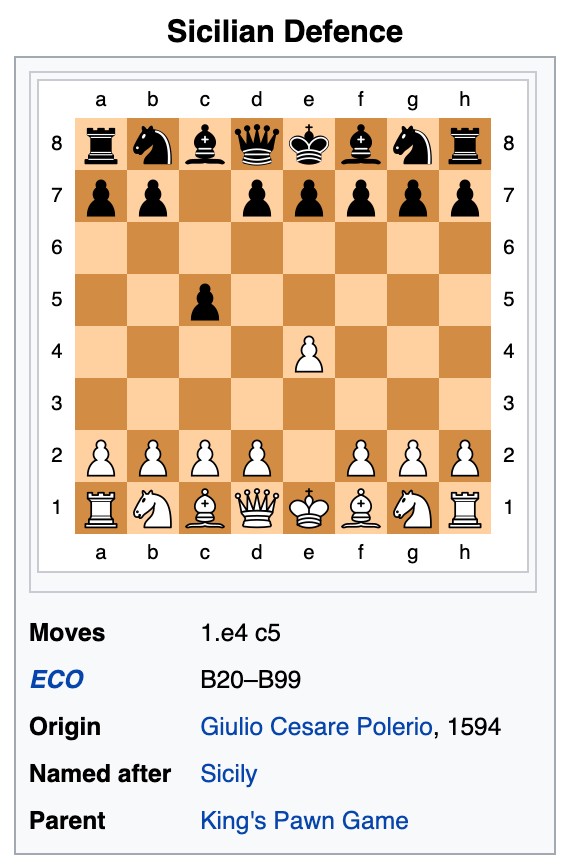The Sicilian Defense is a chess opening played by Black, characterized by the move 1...c5. It is the most popular and best-scoring response to White's first move 1.e4. The Sicilian is a sharp and dynamic opening that often leads to complex, unbalanced positions where both sides have chances to win.
Island of Sicily
The Sicilian Defense gets its name from the island of Sicily, where the opening was first recorded in the late 15th century. It was later developed and popularized by chess players in Italy and Spain, and eventually became a standard choice for Black at all levels of chess.
One of the main ideas behind the Sicilian Defense is to challenge White's control of the center by establishing a pawn on d5. This pawn, supported by the bishop on c8 and the knight on f6, can become a powerful central outpost for Black. In addition, the Sicilian Defense allows Black to develop the bishop on c8 to the more active diagonal a6-f1, which can be very strong if White allows it.

Do you want to capture all Sicilian Defense Games ever played? Download our biggest chess database with 9.2 million human chess games and explore all variations of Sicilian Defense, including Najdorf, Rossolimo, Kalashnikov, Sveshnikov and Accelerated Dragon in details.
Quick counterattack on the queenside
Another important idea in the Sicilian Defense is the potential to launch a quick counterattack on the queenside. By advancing the pawns on a6 and b5, Black can put pressure on White's pawn on a2 and potentially gain space and control on the queenside. This can be particularly effective if White has already committed to attacking on the kingside, as Black can shift the focus of the game to the other side of the board and catch White off guard.
One of the most common variations of the Sicilian Defense is the Open Sicilian, which arises after the moves 1.e4 c5 2.Nf3. In this variation, White often attacks on the kingside with the pawn push f4, while Black counterattacks on the queenside with the pawn advance b5. This can lead to highly tactical and complex positions where both sides have to be careful not to overlook any threats.

Closed Sicilian
A popular variation of the Sicilian Defense is the Closed Sicilian, which arises after the moves 1.e4 c5 2.Nc3. This move order aims to control the center and prevent Black from playing the Sicilian Defense with the moves d6 and e5. It also allows White to develop the knight to a strong central square on d4 and puts pressure on Black's pawn on c5. The Closed Sicilian is a solid and flexible opening that can lead to a variety of different positions. It is often used by players who prefer a positional approach to the game, as it allows White to establish a strong center and control the center of the board.
ECO Codes
The Encyclopaedia of Chess Openings classifies the Sicilian Defence under the codes B20 through B99, giving it more codes than any other opening. In general these guidelines apply:
Codes B20 through B29 cover lines after 1.e4 c5 where White does not play 2.Nf3, and lines where White plays 2.Nf3 and Black responds with a move other than 2...d6, 2...Nc6 or 2...e6.
Codes B30 through B39 cover the lines beginning 1.e4 c5 2.Nf3 Nc6 that do not transpose into lines that can also begin with 2...d6. The most important variations included here are the Rossolimo, Kalashnikov, Sveshnikov and Accelerated Dragon.
Codes B40 through B49 cover the lines beginning 1.e4 c5 2.Nf3 e6, most importantly the Taimanov and Kan variations.
Codes B50 through B59 cover the lines after 1.e4 c5 2.Nf3 d6 not covered in codes B60–B99. This includes the Moscow Variation (3.Bb5+), 3.d4 cxd4 4.Qxd4, and lines in the Classical Variation except for the Richter–Rauzer Attack, including the Sozin Attack and the Boleslavsky Variation.
Codes B60 through B69 cover the Richter–Rauzer Attack of the Classical Variation.
Codes B70 through B79 cover the normal (unaccelerated) Dragon Variation.
Codes B80 through B89 cover the Scheveningen Variation.
Codes B90 through B99 cover the Najdorf Variation.
Overall, the Sicilian Defense is a complex and dynamic opening that offers both White and Black many opportunities for attacking and counterattacking. It is a popular choice among chess players of all skill levels, and its aggressive nature makes it an exciting option for those looking to take the initiative in their games.
Visit and subscribe to our YouTube channel  to learn chess openings and much more.
to learn chess openings and much more.





